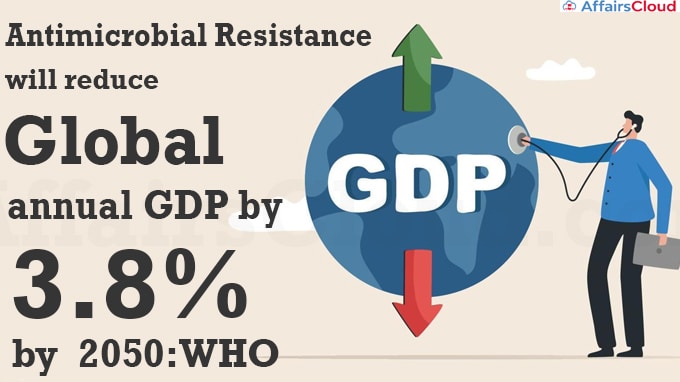 The World Health Organisation (WHO) has stated that In a high-impact scenario, Antimicrobial Resistance (AMR) will reduce global annual Gross Domestic Product (GDP) by 3.8% by 2050. If this situation remains unchecked, in the next decade, this could result in GDP shortfall of USD 3.4 trillion annually and push around 24 million people into extreme poverty.
The World Health Organisation (WHO) has stated that In a high-impact scenario, Antimicrobial Resistance (AMR) will reduce global annual Gross Domestic Product (GDP) by 3.8% by 2050. If this situation remains unchecked, in the next decade, this could result in GDP shortfall of USD 3.4 trillion annually and push around 24 million people into extreme poverty.
- This announcement aims to highlight the need for sustained multisectoral action to prevent and contain AMR during World Antimicrobial Awareness Week (WAAW) from 18th to 24th November 2022.
- This announcement was made by Dr Poonam Khetrapal Singh, WHO Regional Director for South-East Asia.
Key Points:
i.According to new global estimations, in 2019, deaths of around 5 million people was associated with bacterial AMR of which 1.3 million deaths were directly attributable to bacterial AMR.
ii.AMR occurs when bacteria, viruses, fungi and parasites evolve over time and no longer respond to medicines. This makes infections harder to treat and increases the risk of disease spread.
Efforts of WHO:
i.Since 2014, The prevention and combating AMR has been one of the 8 flagship priorities of the WHO South-East Asia Region, at high risk for the emergence and spread of AMR.
ii.The member states are implementing national action plans to address AMR.
iii.In each Member State, a multisectoral working group or coordination committee on AMR has been established in line with the Global Action Plan on AMR, adopted in 2015.
iv.All Member States are enrolled in the Global Antimicrobial Resistance Surveillance System (GLASS) AMR and the South-East Asia Region is the only WHO region in which all countries carry out the annual Tracking AMR Country Self-Assessment Surveys
In 2022, this was expanded to include the environment sector for the first time.
Challenges:
i.According to the review of progress launched at the 75th Session of the WHO Regional Committee for South-East Asia in September 2022, the countries of the Region still face an array of multisectoral challenges.
ii.The challenges include,
- unsafe disposal of medicine and pharmaceutical waste,
- inadequate regulation of antimicrobial use in food production,
- insufficient infection prevention and control in health facilities,
- inadequate access to safe water, sanitation and hygiene in homes and health facilities.
Priorities of the region:
First: To accelerate the implementation of national multisectoral action plans, for which adequate, sustained and reliable financing must be allocated (domestic, international and global).
Second: to improve the surveillance of AMR infections and strengthen the laboratory capacity. This is vital to know the true extent of the issue and to effectively target energy and resources.
Third: to develop and enforce regulations on the appropriate use of antimicrobial medicines in all relevant sectors, and ensure that such regulations promote and facilitate access to appropriate antimicrobial use.
Fourth: to step up the investments in adequate water, sanitation and hygiene, a critical health intervention. This will also have a significant impact on the tsunami of environmental pollution and contamination-driven antimicrobial resistance.
One Health Action:
As a part of WAAW 2022, the One Health Quadripartite(WHO, the Food and Agriculture Organization of the United Nations (FAO), the World Organization for Animal Health (WOAH), and the United Nations Environment Programme (UNEP)), highlighted the need to increase One Health action to address AMR with the theme “preventing antimicrobial resistance together”.
- The one health action will increase national, Regional, international and global awareness and support to address AMR.
Over 1 billion young people are at risk of hearing loss: Study
According to the research published in open access journal BMJ Global Health, more than 1 billion teens and young people are potentially at risk of hearing loss because of their use of headphones and earbuds and attendance at loud music venues.
- The study states that young people are particularly vulnerable due to their use of personal listening devices (PLDs).
- WHO estimates that more than 430 million people across the globe currently have disabling hearing loss. This number could rise to over 2.5 billion by 2050.
Key Points:
i.The previously released research study states that PLD users often choose volumes as high as 105 decibels (dB) while average sound levels at entertainment venues range from 104 to 112 dB. This exceeds the permissible sound levels of 80 dB for adults and 75 dB for children even if for very short periods.
ii.The research included 33 studies, corresponding to data from 35 records(17 records focused on PLD use and 18 focused on loud entertainment venues) and 19,046 participants.
About World Health Organisation (WHO):
Director General– Dr Tedros Adhanom Ghebreyesus
Headquarters– Geneva, Switzerland
Established in 1948




